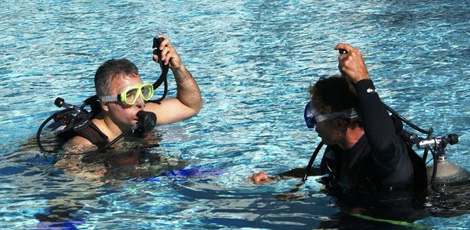Key West Scuba Diving Safety Tips

Scuba diving is considered to be safer than many conventional sports. Although diving accidents tend to make the news, such events are statistically rare: about 2-3 fatalities per 100,000 dives. Injuries are far less frequent than they are in other popular sports.
The drive to the dive center is more dangerous than the dive. But diving does present an element of risk. That’s why entry-level dive courses include rigorous instruction in dive planning and execution along with specific safety training and preparation for dealing with dangerous situations that might arise.
Although there is a lot to learn, most divers consider planning for safety, managing risk, and being ready to deal with emergencies to be part of the challenge and fun of diving. Here are a few core guidelines to keep in mind for safe Key West scuba diving.
1. Get Certified
There is really no way around getting your PADI (Professional Association of Diving Instructors, NAUI (National Association of Underwater Instructors, or SSI (Scuba Schools International) training and certification. Reputable dive operators will require it before allowing you to join a dive trip. Dive shops will not provide scuba tank fills to uncertified individuals. Fun, safe diving is based on proper training, and the ideal approach is to continue learning and skills development on an ongoing basis.
2. Be Dive-Ready
Physical and mental health along with general fitness level plays a major role in your diving capabilities and in dive safety. The underwater portion of diving is often quite relaxing, but diving can involve long surface swims, maneuvering against strong currents, exposure to cold, and other strenuous factors. Fatigue, obesity, alcohol and tobacco use, and illness all increase risk while diving. Be sure you feel up to any given dive session. If you don’t feel right, skip the dive.
3. Plan Thoroughly
“Plan your dive, dive your plan” is a standard scuba diving maxim. It is vital to properly plan every dive including establishing maximum depth and bottom time and safe ascent procedures. Emergency and lost diver responses should be agreed on and hand signals need to be reviewed. If you are diving with a group on a descent planned and led by a dive master, be sure to pay careful attention to the pre-dive briefing and record information as needed.
4. Buddy Up
The buddy system is a foundation of safe scuba diving. On dive boats, you will often be paired with strangers, including divers from other countries. Make sure to communicate with your buddy before the dive to work out hand signals and review the dive plan.
5. Watch Your Gauges
Check your gauges frequently. It is easy to get wrapped up in the underwater experience, lose track of time, and end up dangerously low on air or even cutting into your decompression reserve. Diver fatality statistics reveal that insufficient air supply is a leading cause of fatal emergency ascents. Use dive computer alarms if they are available.
Safe Diving is Easy
It is not difficult to minimize risk and fully enjoy every dive. Preparation, skill, and simple common sense go a long way toward making every dive successful. Soon, following safe dive procedures becomes an ingrained, unconscious part of your collection of good dive habits, leaving you free to relax and have fun scuba diving in Key West.











